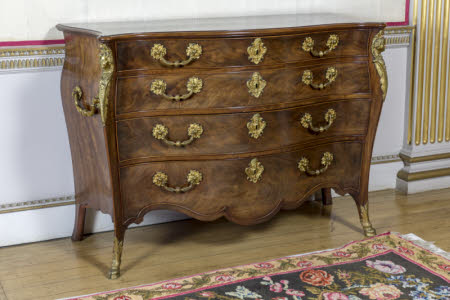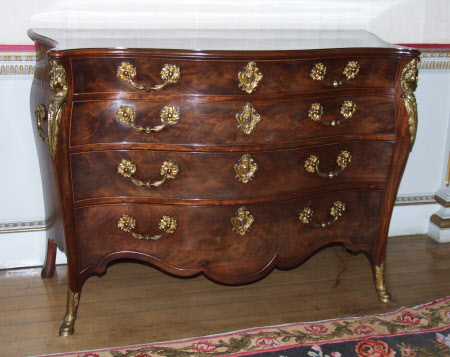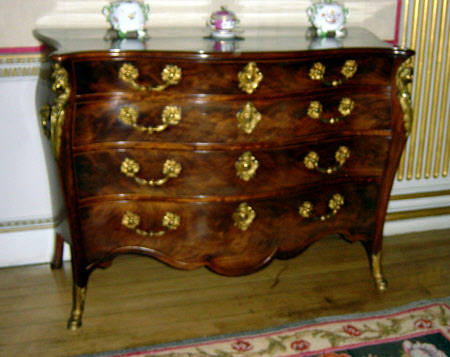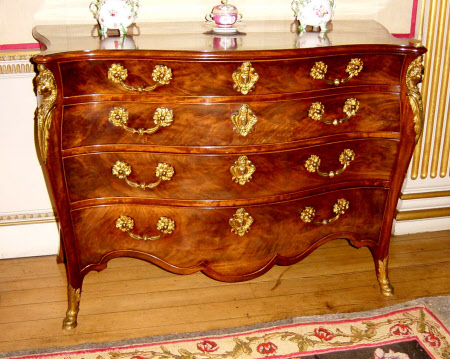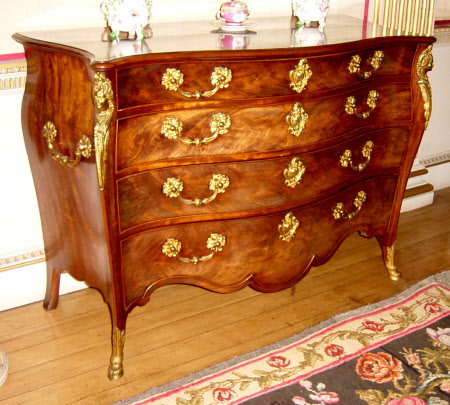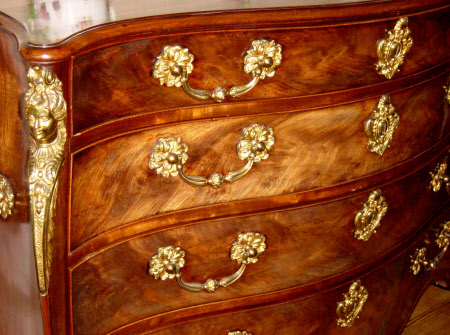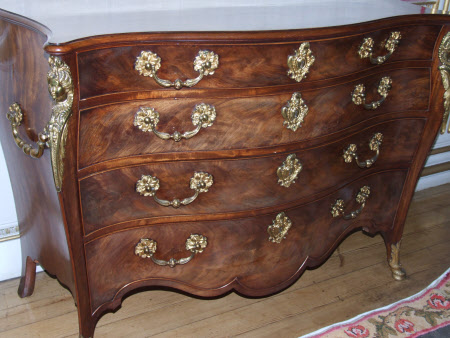Commode
attributed to John Cobb (1715 - 1778)
Category
Furniture
Date
circa 1760 - 1770
Materials
mahogany veneer, solid mahogany, deal and oak construction, gilt bronze
Measurements
93.8 x 132.2 x 60.4 cm
Place of origin
London
Order this imageCollection
Blickling Hall, Norfolk
NT 354321
Summary
A mahogany and gilt bronze mounted commode, attributed to John Cobb (1715-1778) London, circa 1760 Of bombe form with a serpentine top with molded edge above four long drawers, the lower drawer with a shaped apron and flanked by outset corners with applied cast caryatid mounts. The splayed feet with goats hoof cast sabots, the drawers with drop handles and with larger conforming handles to the sides.
Full description
This commode and the mahogany dressing table (NT354318) were items almost certainly supplied by John Cobb, who was paid £86 in 1762 by Lord Buckinghamshire. The pair of commodes (NT354356) are also almost definitely by Cobb's workshop but may have been supplied at a slightly later date It is believed that John Cobb (1715 - 1778) was apprenticed in 1729 to Timothy Money (fl 1724–59), a Norwich upholsterer. In 1755 he married Sukey, a daughter of the cabinetmaker Giles Grendey, and is said to have acquired a ‘singularly haughty character’, strutting ‘in full dress of the most superb and costly kind...through his workshops giving orders to his men’. He worked with William Vile from 1750 until 1765 in premises at No, 72, the corner house of St. Martin's Lane & Long Acre. In the early 1750s, William Hallett another cabinetmaker of the time, formed a working syndicate with Vile & Cobb. Vile and Cobb supplied furniture to the leading patrons of the day including George III and Queen Charlotte, the 1st Earl of Leicester at Holkham Hall, the 4th Duke of Devonshire at Chatsworth and the 4th Duke of Bedford at Woburn Abbey. Vile and Cobb held the Royal Warrant from 1761 until April 1764 when Vile retired. While Vile created works in an Anglicized Rococo style, Cobb’s furniture of the 1770s was executed in an elegant Neoclassical style. Cobb’s haughty disposition which did not always endear him to his customers, so the Royal Warrant was awarded to two of their employees William France and John Bradburne instead of Cobb himself. Some of Cobb's work is in the Royal Collection at Buckingham Palace. Following Vile's retirement in 1764, Cobb carried on in business with the assistance of his foreman, Samuel Reynolds (fl. 1751–85). He made furniture to very high standards and earned a reputation for exquisite marquetry. After Cobb’s death in 1778, Samuel Reynolds operated in partnership with John Graham at Cobb’s address at 72 St Martin’s Lane, London, until 1785. See Lucy Wood, 'Catalogue of Commodes' 1994 pg.43-53 (James Weedon, 2016) .
Provenance
Part of the Lothian Collection. The hall and contents were bequeathed to the National Trust in 1940 by Philip, 11th Marquess of Lothian (1882-1940) This commode was almost certainly supplied by John Cobb for the state bedroom at Blickling.
Makers and roles
attributed to John Cobb (1715 - 1778), cabinetmaker attributed to John Cobb (1715 - 1778), furniture designer
References
Beard, Geoffrey W. Dictionary of English furniture makers, 1660-1840 1986., pg.181-184 Wood, 1994: Lucy Wood, The Lady Lever Art Gallery, Catalogue of Commodes, London, 1994, pgs. 43-53
